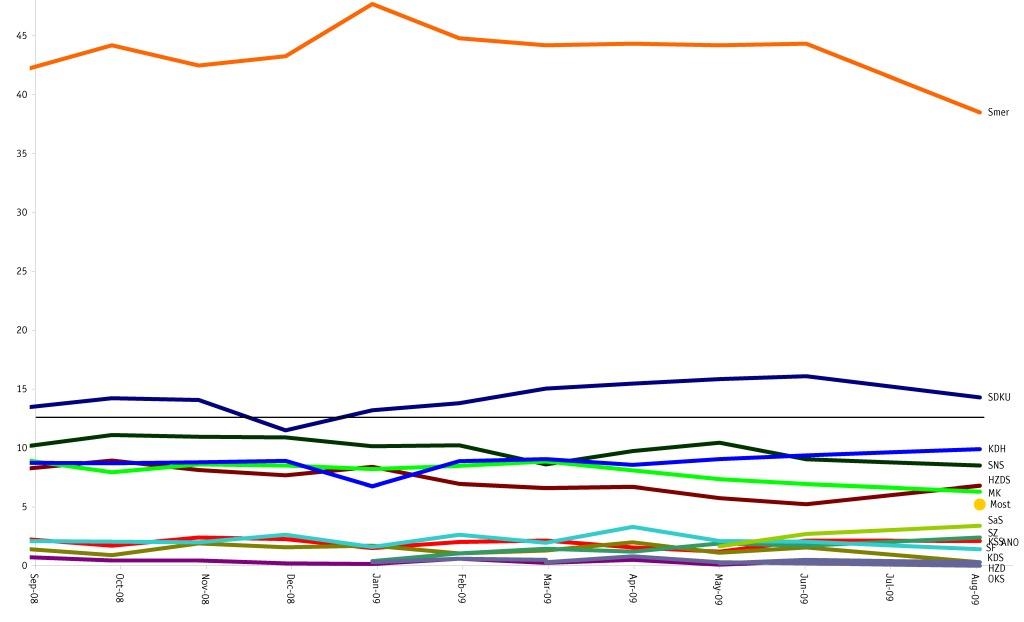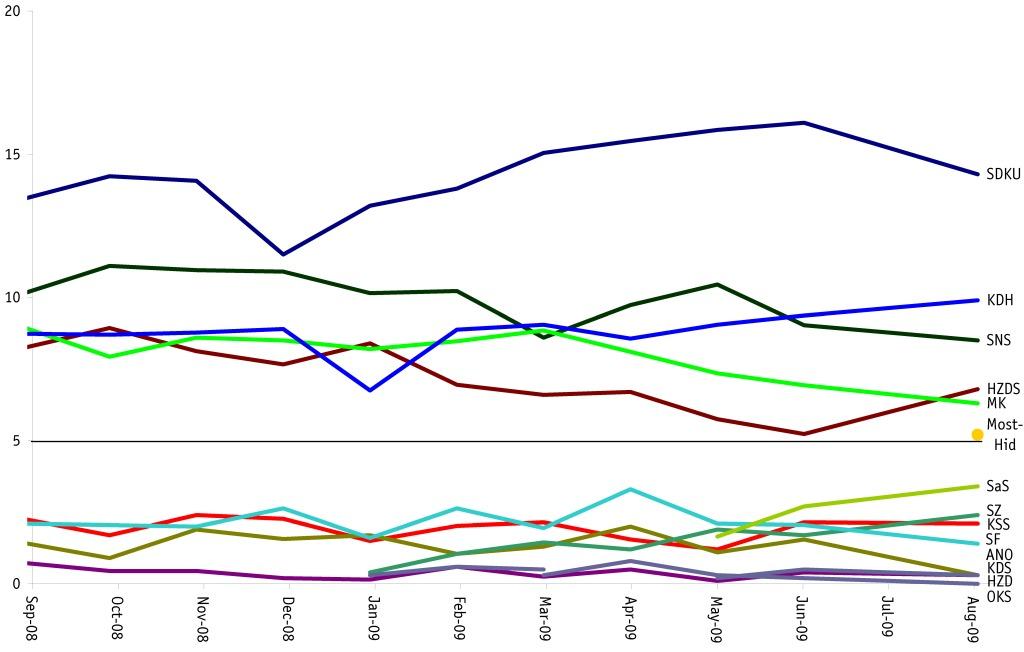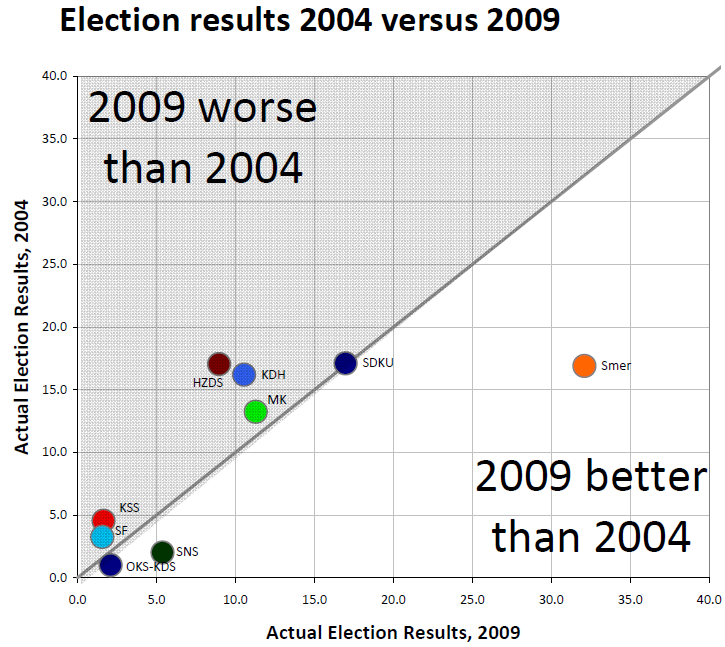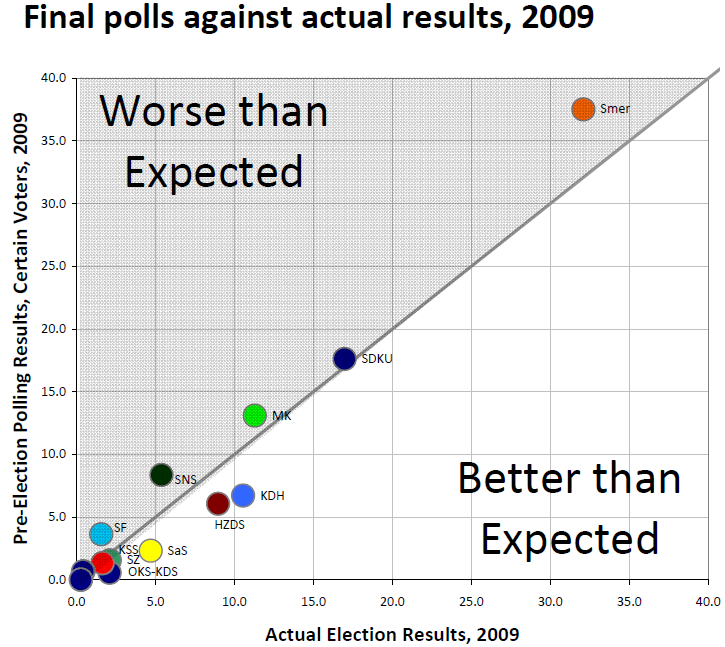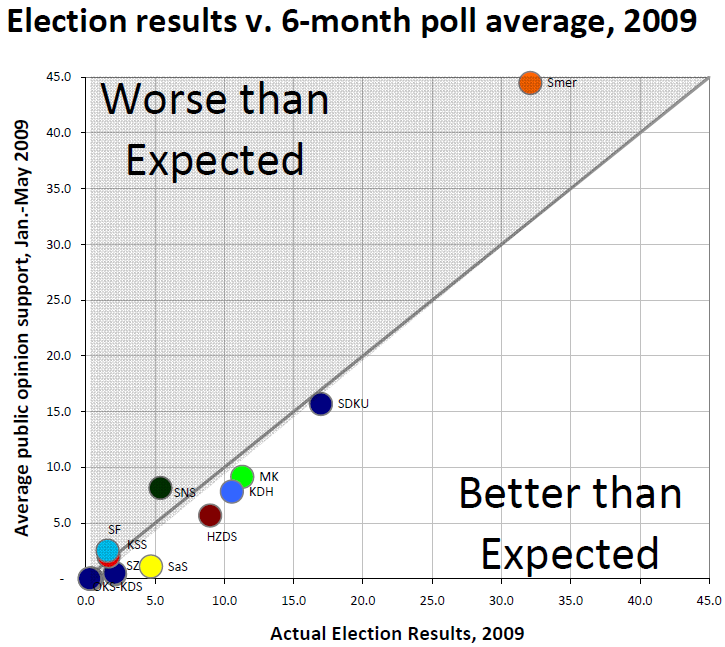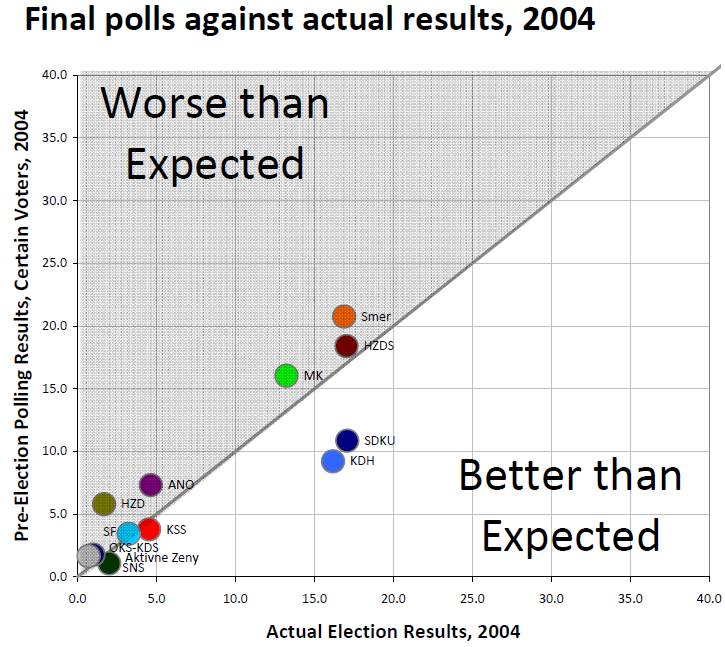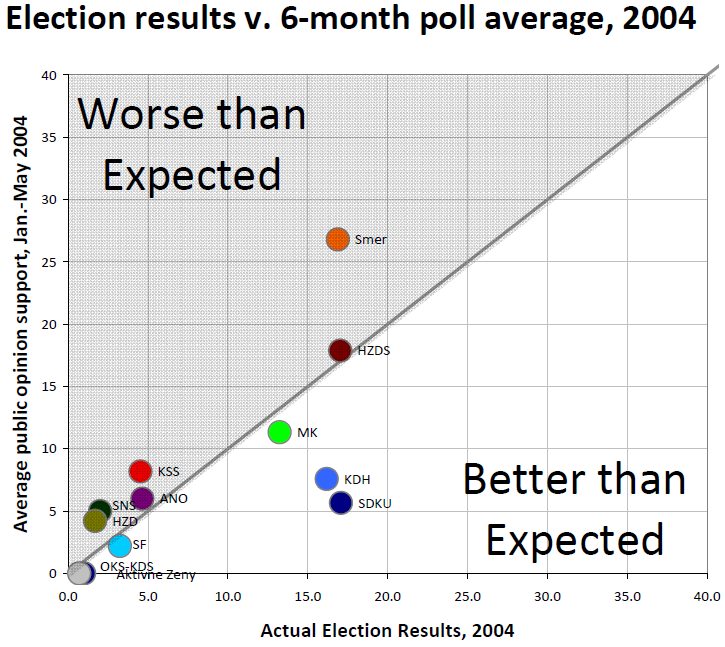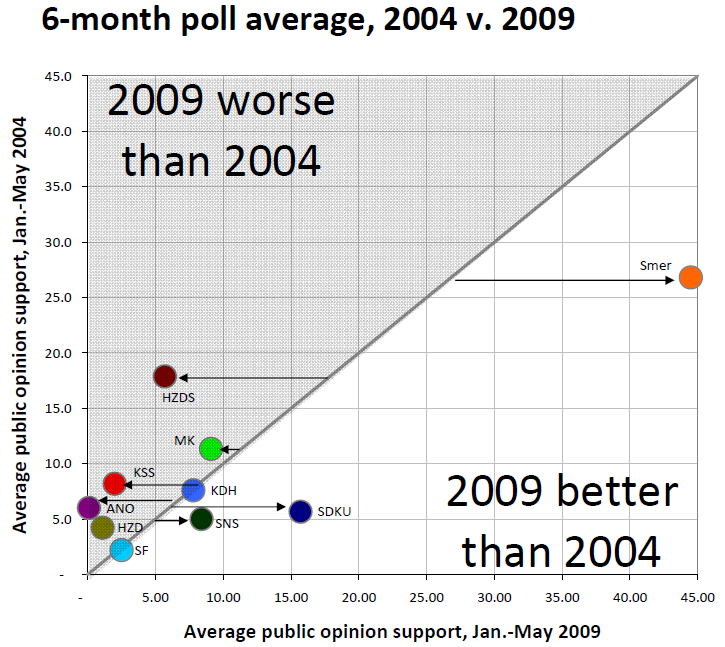 With 8 parties potentially entering Slovakia’s parliament there are 255 different coalition possibilities. Fortunately, not withstanding Bismark’s aphorism that “Politics is the art of the possible,” there are quite a few coalition possibilities that we can exclude and in the end we can narrow down the possibilities to a relatively small number. In the paragraphs below, I do this as systematically as I can by excluding (with great care) individual relationships that simply will not work and ranking others by probability, and then with guesses about which of the remainder will manage to muster a sufficient number of seats. Those who don’t want to read the whole process by which I reached the answer can jump down to the bottom and look at the pretty graph:
With 8 parties potentially entering Slovakia’s parliament there are 255 different coalition possibilities. Fortunately, not withstanding Bismark’s aphorism that “Politics is the art of the possible,” there are quite a few coalition possibilities that we can exclude and in the end we can narrow down the possibilities to a relatively small number. In the paragraphs below, I do this as systematically as I can by excluding (with great care) individual relationships that simply will not work and ranking others by probability, and then with guesses about which of the remainder will manage to muster a sufficient number of seats. Those who don’t want to read the whole process by which I reached the answer can jump down to the bottom and look at the pretty graph:
Coalition (im)possibilities: What can we exclude?
I heartily accept Charles Dudley Warner’s conclusion that “Politics makes strange bedfellows” and I am no longer surprised when lifelong enemies join forces against a new opponent, so it is a dangerous business to say that “Party A” will not form a coalition with “Party B.” In fact, as I learned the hard way, it is still a dangerous business even when the leader of “Party A” has said it himself. For example:
(HZDS leader Vladimir) Meciar only ruled out post-election cooperation with the Slovak National Party (SNS). “This is because of its low political culture, vulgarism, and inclination toward unethical behavior, and I cannot cooperate with Jan Slota (SNS leader).” Sme, Tuesday, April 11, 2006 T08:49:17Z:
Since this statement led me to discount the combination that emerged 3 months later and that has governed in Slovakia during the past four years, I now think it wise to seek out other standards. What leaders say can be helpful but only if backed up by something else. Unfortunately, that something else is the rather insubstantial notion that barring alien invasion, some parties very reasons for being exclude coalitions with other parties and whose electoral existence would be threatened by the combination. There are only a few of these:
- Slovak National and Hungarian National: It is hard to envision a coalition between the Slovak National Party (SNS) and the Hungarian parties, Most-Hid and MKP-SMK. It would be very hard for the Slovak National Party to accept partnership with parties it tried to ban, even if the Hungarian parties were willing to accept.
- Left and Right: It is hard to envision a coalition between Smer and Freedom and Solidarity (SaS) or the Slovak Democratic and Christian Union (SDKU). This one’s a bit less certain because the economic dimension is not quite as bitter as the national one, but from its beginning SaS pointed to Smer as its chief opponent and differentiated itself from other parties on its same side of the political spectrum (especially SDKU) precisely on its unwillingness to form a coalition with Smer. For an older, more established party, it might be possible to go back on the promise, but SaS doesn’t have too much else to offer.
 This reduces the range of party relationships a bit and drops the total number of coalition permutations to 119:
This reduces the range of party relationships a bit and drops the total number of coalition permutations to 119:
The next step is to eliminate combinations that are highly unlikely, on the basis of leader statements backed by some fundamental opposition that would cost a party major support if it joined with another. Here I would suggest several candidates:
- Right and Slovak National: KDH, SDKU and SaS are highly unlikely to form a coalition with SNS. It is not impossible that right-wing parties might join with SNS, but it is hard to imagine the circumstances. SNS has used such strong national rhetoric and has faced so many corruption allegations that even Smer has found the combination difficult. For the right wing parties, whose voters are less nationally oriented and who are likely more sensitive than Smer to the opinions of international partners, the combination would be even more difficult. Furthermore, any seats that SNS would bring to a right-wing coalition would be more than offset by the loss of any possibility of Hungarian seats.
- Let and Right: It is also hard to envision a coalition between Smer and SDKU. At one time the combination seemed utterly impossible given Fico’s hatred for Dzurinda; now that Dzurinda will no longer be the electoral leader of SDKU, it might be a bit easier, but Fico has just as much disdain for one of the leading candidates for SDKU leader–Miklos–and the other leading candidate, Radicova has recently sharpened her rejection of this kind of coalition.
 Since coalitions can occur only if all parties are willing to pair with all others, this drops the number of permuations to a (slightly) more reasonable 83.
Since coalitions can occur only if all parties are willing to pair with all others, this drops the number of permuations to a (slightly) more reasonable 83.
In addition to these, there are a number of hard relationships, those which would be made difficult either by personal animosity or by potential loss of support. This category—where I should have placed HZDS-SNS in 2006—is a bit larger but doesn’t help us much as it merely raises the cost of coalitions rather than preventing them altogether. Still, these combinations are worth noting as “expensive”
- Right and Slovak national. It is not impossible to exclude a coalition between HZDS and KDH, SaS, MKP-SMK and Most-Hid, but past conflicts between HZDS and the right and Hungarian national parties are still vivid enough that such a coalition, while possible, would not be easy. KDH in particular has resisted any connection with HZDS but the Hungarian parties are also disinclined. SaS leader Sulik has moved from a statement that a coalition with HZDS would be a lesser evil, to a statment that HZDS leader Meciar should be “behind bars.”
- Left and Right. The only left-right coalition not excluded above is Smer with KDH. This is the one that is merely unlikely rather than hard to imagine. The coalition would be hard to accept for Smer voters and especially hard for KDH voters. Recent comments by KDH chair Figel about Smer are sharper than in the past and a coalition would likely hurt KDH with its supporters, but it can’t be excluded entirely.
- Left and Hungarian national. Both Hungarian parties, for their part, seem desirious enough of entering government that they would probably be able to overlook Smer’s past rhetoric on national questions but Smer has put a lot of energy into criticizing Hungarians and so would find it difficulty (though probably not impossible) to choose a Hungarian partner as it would lose a relatively strong electoral appeal. Since, as below, Most-Hid and MKP-SMK are not getting along well at the moment a coalition between Smer and only one of the Hungarian parties would be slightly less fraught, but might be no more desirable to Smer and would have a lower chance of gaining a majority.
- Hungarian and Hungarians. Ultimately a conclusion may well include MKP-SMK with Most-Hid but doing so will take some work as the leaders of the two parties dislike each other intensely and the rhetoric has becoming sharper.
We can also do a preliminary assessment of the mathematical possibilities of coalitions, using a maximalist version of current party support. A coalition of SDKU and SaS might work nicely but the party has no practical chance of a parliamentary majority. We can exclude electorally impossible coalitions by taking current poll results and (for safety’s sake) giving each party a 30% bonus (assuming maximal poll error in a party’s favor). This brings the number of even barely viable coalitions down to “only” 27.
From this, furthermore, we can remove 7 coalitions as containing redundant members (eliminating the smallest still leaves more than 80 seats by current estimates). This brings us down to 19.
Coalition possibilities: What’s left:
For simplicity we can further categorize these coalitions by similarities among members. The graph below tries to makes sense of these many options by comparing them along two axes: from left to right a internal compatibility of coalitions (related to the “expensiveness” of coalition pairings discussed above but based on my own highly-arguable judgment rather than any quantitative measure) and from bottom to top an expected number of seats based on current month polls. Least likely coalitions are in the lower left; most likely in the upper right.
The coalitions in terms of likelihood are, therefore:
 Smer + Slovak National: From an electoral perspective, the current coalition has a strong chance of return, and is not utterly unpalatable for the coalition members. Slightly more internally compatible would be a subset of the current coalition—Smer with either HZDS or SNS—but this has a somewhat lower chance of sufficient electoral success.
Smer + Slovak National: From an electoral perspective, the current coalition has a strong chance of return, and is not utterly unpalatable for the coalition members. Slightly more internally compatible would be a subset of the current coalition—Smer with either HZDS or SNS—but this has a somewhat lower chance of sufficient electoral success. Smer + Hungarian National: A coalition between Smer and both Hungarian parties is electorally possible but less mutually desirable by its member.
Smer + Hungarian National: A coalition between Smer and both Hungarian parties is electorally possible but less mutually desirable by its member.
- Smer + Hungarian National + Slovak National: Adding HZDS to this mix is theoretically possible but probably would not be necessary in electoral terms and would add consideral internal incompatibility
 Smer + Right: It is hard to imagine a coalition between Smer and a “right” party except KDH and even this would be unappetizing for Smer (though perhaps moreso than a coalition with Hungarian parties) and even less so for KDH.
Smer + Right: It is hard to imagine a coalition between Smer and a “right” party except KDH and even this would be unappetizing for Smer (though perhaps moreso than a coalition with Hungarian parties) and even less so for KDH.- Right + Hungarian National: A coalition resembling the 2002-2006 Dzurinda government is
 certainly a possibility in terms of internal compatibility (these parties conflicted with one another when in government but seem willing to tolerate one another rather than see another Fico government). From an electoral perspective, however, these are highly unlikely.
certainly a possibility in terms of internal compatibility (these parties conflicted with one another when in government but seem willing to tolerate one another rather than see another Fico government). From an electoral perspective, however, these are highly unlikely.
- Right + Hungarian National + Slovak National: Adding HZDS to this coalition could perhaps
 push this coalition into a parliamentary majority but only by adding so much internal incoherence as to make it highly unlikely. It is hard to imagine what incentives could inspire HZDS to chose this coalition rather than one with Smer but the party is certainly relying on having more bargaining potential than SNS, for whom Smer is the only coalition choice.
push this coalition into a parliamentary majority but only by adding so much internal incoherence as to make it highly unlikely. It is hard to imagine what incentives could inspire HZDS to chose this coalition rather than one with Smer but the party is certainly relying on having more bargaining potential than SNS, for whom Smer is the only coalition choice.
- Right + Hungarian National + Slovak National: Adding HZDS to this coalition could perhaps
Both of these are only very rough indicators of the actual factors (coalitionability and electoral strength) but they are the best I can come up with at the moment. I will try to nuance these as the election nears. One nuance, worth thinking about now, however, is the fact that Slovaka’s electoral system does not make a smooth equivalence between seats and votes but rather imposes (as most countries do) a 5% threshold. Since 5 of Slovakia’s 8 major parties have support near 5%, a small change in support can have major impact on the composition of parliament and these deserve consideration in the next post.



